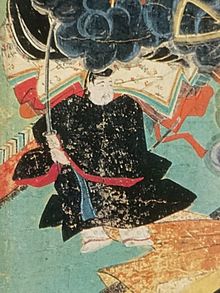| Senior First Rank Fujiwara no Tokihira 藤原時平 | |
|---|---|
 | |
| Born | 871 |
| Died | April 26, 909(909-04-26) (aged 37–38) |
| Nationality | Japanese |
| Parents | Fujiwara no Mototsune (father) |
Fujiwara no Tokihira (藤原 時平, 871 – April 26, 909) was a Japanese statesman, courtier, regent and politician of the powerful Fujiwara clan during the Heian period.
Career
Tokihira was a minister under Emperor Daigo.
- 891 (Kanpyō 3, 3rd month): Tokihira was given a rank which was the equivalent of sangi.
- 897 (Kanpyō 9, 6th month): Tokihira was made Dainagon with a rank equal to that of a General of the Left.
- 899 (Shōtai 2): Tokihira was named Sadaijin
- 900 (Shōtai 3): Tokihira accused Sugawara no Michizane of plotting against the emperor. This led to Michizane's exile to the Dazaifu in Kyūshū.
- 909 (Engi 9, 4th month): Tokihira died at age 39. He was honored with posthumous rank and titles.
Genealogy
This member of the Fujiwara clan was the son of Fujiwara no Mototsune. Tokihira had two brothers: Fujiwara no Tadahira and Fujiwara no Nakahira.
- Father: Fujiwara no Mototsune
- Mother: Daughter of Imperial Prince Saneyasu
- Wife: Princess Renshi (廉子女王), daughter of Imperial Prince Motoyasu
- 1st Son: Fujiwara no Yasutada (藤原保忠; 890-936)
- Daughter: Fujiwara no Hōshi (藤原 褒子), consort of Emperor Uda
- Daughter: Fujiwara no Hitoshi (藤原 仁善子)
- Wife: Daughter of Minamoto Jin
- 2nd Son: Fujiwara no Akitadata (藤原顕忠; 898-965)
- Wife: Daughter of Ariwara no Muneyana
- 3rd Son: Fujiwara no Atsutada (藤原敦忠; 906-943)
- Wife: Unknown
- Daughter: Concubine of Fujiwara no Saneyori
- Daughter: Wife of Imperial Prince Atsumi
- Daughter: Wife of Imperial Prince Yoshiakira
Selected works
In a statistical overview derived from writings by and about Fujiwara no Tokihira, OCLC/WorldCat encompasses roughly 35 works in 69 publications in 1 language and 122 library holdings.
This is a dynamic list and may never be able to satisfy particular standards for completeness. You can help by adding missing items with reliable sources.- Sandai jitsuroku (三代實).
- Engi shiki (延喜式).
See also
Notes
- ^ Nussbaum, Louis-Frédéric. (2005). "Fujiwara no Tokihira" in Japan Encyclopedia, p. 210, p. 210, at Google Books; Brinkley, Frank et al. (1915). A History of the Japanese People from the Earliest Times to the End of the Meiji Era, p. 203., p. 203, at Google Books
- Titsingh, Isaac. (1834). Annales des empereurs du japon, p. 127., p. 127, at Google Books; see "Fousiwara-no Toki fira", pre-Hepburn romanization
- Titsingh, p. 129., p. 129, at Google Books
- Titsingh, p. 130., p. 130, at Google Books.
- Brinkley, p. 244., p. 244, at Google Books; excerpt, "...three principal contrivers of Michizane's disgrace Fujiwara Tokihira, Fujiwara Sugane, and Minamoto Hikaru ...."
- Brinkley, p. 249., p. 249, at Google Books; excerpt, "From one point of view, Michizane's overthrow by Fujiwara Tokihira may be regarded as a collision between the Confucian doctrines which informed the polity of the Taika epoch and the power of aristocratic heredity."
- Titsingh, p. 132., p. 132, at Google Books.
- Brinkley, p. 241., p. 241, at Google Books
- WorldCat Identities Archived December 30, 2010, at the Wayback Machine: 藤原時平 871-909
References
- Brinkley, Frank and Dairoku Kikuchi. (1915). A History of the Japanese People from the Earliest Times to the End of the Meiji Era. New York: Encyclopædia Britannica. OCLC 413099
- Nussbaum, Louis-Frédéric and Käthe Roth. (2005). Japan encyclopedia. Cambridge: Harvard University Press. ISBN 978-0-674-01753-5; OCLC 58053128
- Titsingh, Isaac. (1834). Nihon Odai Ichiran; ou, Annales des empereurs du Japon. Paris: Royal Asiatic Society, Oriental Translation Fund of Great Britain and Ireland. OCLC 5850691
| Fujiwara family tree | |
|---|---|
Notes
|